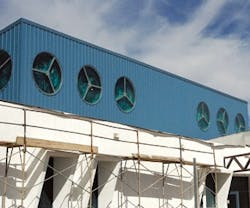Expectations for a Greener Tomorrow
Return to Introductory Article
Theory and practical application have converged in Tucumcari, NM, home to the North American Wind Research and Training Center at Mesalands Community College, where 59 students are currently pursuing associate degree training in wind energy technology.
This forward-thinking field of study doesn't rely solely on simulations and textbook illustrations, however; a 1.5-megawatt, commercial-grade wind turbine – dubbed "the tallest classroom in the world" – enhances the curriculum by offering hands-on experience in mechanical systems, power generation and distribution, and diagnosis and repair. In addition to its educational contribution to the program, the wind turbine also has a useful purpose. When it is generating electricity, it embodies Mesalands' commitment to the future of renewable energy by helping to power the 26,000-square-foot research/training facility. Revenue provided by any excess energy, which is put on the national grid, helps fund the college's entire electricity bill.
FINALIST:
North American Wind Research and Training Center
CATEGORY: GREEN FACILITIES
Such a win-win situation might seem like a no-brainer, but the learning curve in turning this program and project from dialogue into reality was no small task, according to Dr. Phillip O. Barry, president of Mesalands Community College. When the college's interest in the concept of wind and renewables was piqued in 2004, Mesalands moved forward in developing the concept, eventually receiving state appropriations to conduct a feasibility study and formal business plan that detailed the type of turbine needed, cost of erection, and long-term revenues and expenses.
"The wind turbine was a critical element in having this North American Wind Research and Training Center," explains Barry. "To teach students on anything less than a commercial-grade turbine would be cheating them." Over the next three years, the college continued to solicit funds from the state and local governments. Barry's next move: Teaming up with the famed Sandia National Laboratories in nearby Albuquerque to research new technologies in wind energy, the first-ever partnership between a national laboratory and a two-year school. The synergy grew to include collaboration with Tucumcari Economic Development Corporation; New Mexico Economic Development Department; New Mexico Energy, Minerals, and Natural Resources Department; Coalition for Clean Affordable Energy; and Regional Development Corporation.
Such perseverance and cooperation has paid off: In August 2008, the first class of wind energy students began their training at Mesalands Community College; the General Electric wind turbine became fully operational in December 2008; and construction of the new North American Wind Research and Training Center commenced in late 2009, financed through a $7 million New Mexico Government Obligation (GO) bond.
This month, Mesalands' pledge to a renewables future has been realized, as the new North American Wind Research and Training Center opens its doors. The facility contains a display area, an auditorium, lecture halls, classrooms, offices, and hydraulic and electric labs. A shop complex with high-bay doors at each side ensures pull-through capabilities for trucks carrying wind turbine components. In the elevated front facade of the prefabricated steel structure, an aesthetically pleasing array of windows depicts wind turbine blades in rotation and serves as a statement of the building's function.
Currently pursuing LEED Silver certification, the facility's energy-efficient capabilities include underground cisterns for rainwater harvesting, abundant natural lighting through windows and skylights, and carbon-neutral status on windy days. The greatest satisfaction, says Barry, is "the fact that we're doing it right. By having the turbine and the facility in which to teach it, we've made a full commitment to commercial wind."

